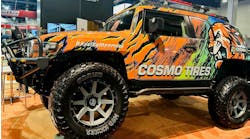Mobile tagging is the process of providing data read from tags for display on mobile devices (source: Wikipedia). These are commonly encoded in a two-dimensional barcode and use the camera of a cell phone as the reader device. The content of the tag code is usually a URL for information that is addressed and accessible through the Internet.
There are dozens of different 2D barcode standards. However, there are approximately 12 that are popular today with mobile phone users. In addition, Microsoft has developed their own proprietary tag identified by small multi-colored triangles.
Do you use mobile barcodes? You may have noticed that they are popping up everywhere. You almost need a smartphone to read your favorite magazine these days. Every ad and article seems to have a mobile barcode printed next to it. Take a walk down Main Street, USA and you will find mobile barcodes in many storefront windows. Stroll through a shopping mall and you will find them in store entry ways and throughout store shelves everywhere.
Setting the standard
QR-Codes seem to be the most popular. They are square diagrams that look like they are comprised of many small little boxes. They have slightly larger solid boxes in three of the corners — it almost looks like a maze.
To read them, you need to download an app on your smartphone, and most of the QR code-reader apps are free. Some of the popular ones are RedLaser from Occipital, Scan from QR Code City, QR Reader from TapMedia, LTD, Nokia Reader from Nokia, and i-nigma Reader from i-nigma.
For you, it’s not important which reader is used, except for the fact that most readers can only read one type of code, their own.
There are some open-source readers available that can read more than one code standard, and many smartphone users have already figured out how to use them.
Getting started
What’s really important is what these mobile barcodes can do for you and how you can use them in your business. To use them to your advantage, you need to be able to create them. There are many free, and not-so-free, mobile barcode generators; most people prefer the free ones.
The generators are the software tools that create those cute little icons. Once you decide which standard you want to use, you can easily download an app that creates the 2D mobile barcodes and you can start creating them. When you create a mobile barcode image, it is saved as a graphic file, like a .gif, .jpeg, or .png file. You can attach the file to emails or upload them to a website just like any other graphic image.
You can also use them in print to include them on letterhead, invoices, window displays, billboards, advertisements, mailings, counter posters, showroom posters, and business cards. The list is endless; I think you get the point.
[PAGEBREAK]
Now what?
What information can you put in these mobile barcodes? Lots of things, and this is where the marketer in you should be getting excited.
You can encode something as simple as a phone number, or a website address. Or you can get fancy and include a specific website landing page, an SMS (text) message, an email message, contact details (such as a Vcard), an event that is automatically entered into an electronic calendar, a Google maps location, a social media launch, a link to a YouTube video – again, the list is endless.
You will be amazed at the information you can share with customers by using mobile barcodes, and at just how powerful they can be. Here’s a great example, you can create a mobile barcode that will compose text message on a phone and send it. All the user has to do is scan the mobile barcode with their smartphone and press send, and off goes the text message sharing your business information with a “friend.” That is social media marketing at its finest – instant sharing of information!
These barcodes also can initiate a text message and send it directly to the user. When scanned, the user will receive a text message in their inbox reminding them about your business or even offering them a discount for repeat business.
Mobile barcodes can also contain links to a webpage that provides extensive information about products or processes. They can even link to a video that explains a safety feature, or shows the reasons that certain services need to be performed, like the importance of tire rotations.
I found one of these codes in a magazine ad recently. The advertisement had several pictures of clothes and accessories and a model was pictured standing right in the middle of the ad. Once I scanned the code, the model’s image appeared on the screen of my phone. It then allowed me to drag the various outfits and accessories toward the model; as I did this, the items would instantly appear on the model on the screen of my phone. How cool is that? Imagine doing that with a car, some tires, and wheels. Even cooler.
Think of the possibilities!
Now it’s time to get creative; imagine what you can do with these little boxes! You can put them on tires and other products in your showroom. When scanned, they could direct the customer to a video that describes the tire, explains its features and benefits, and even gives pricing information. You can put a barcode in your showroom window, or on the showroom wall, that invites users to a website and allows them to join your online loyalty club – or sends them a text message to remind them to sign up.
You can include these barcodes in your print ads to direct customers to your website, or to a video that promotes this week’s specials or even an upcoming event. Imagine putting one on a billboard. People passing by the billboard can use their smartphone to read the mobile barcode and get information about your business while on the road. The possibilities are endless and only limited by your imagination.
I think one of the most purposeful uses for a tire dealer is putting links to videos or webpages that give customers more information about what you are promoting. This isn’t something you could do easily before the invention of mobile barcodes.
What’ll they think of next?
As CEO and president of WECnology LLC (www.wecnology.com), Wayne Croswell is a “complimentary technology advisor” for independent tire dealers. Croswell can be reached at [email protected] or (603) 249-5530.



